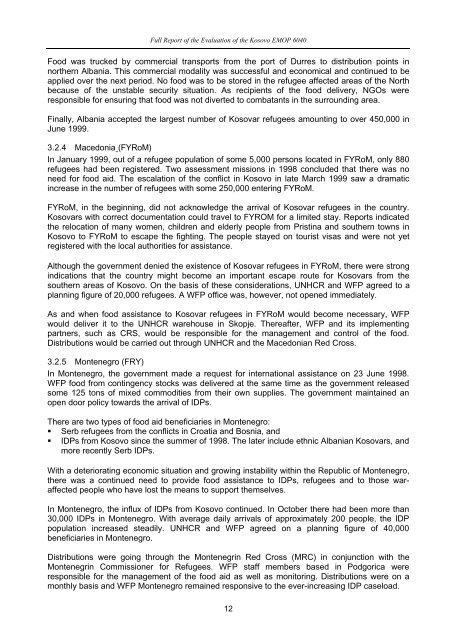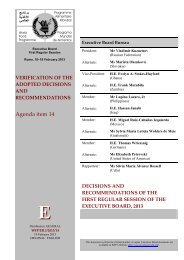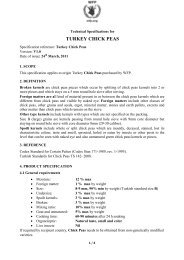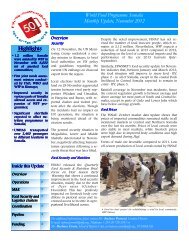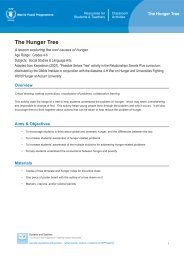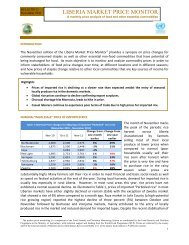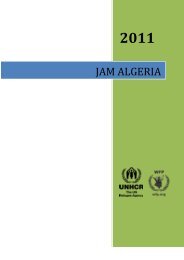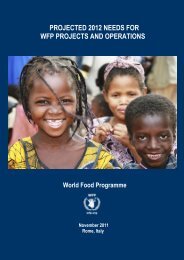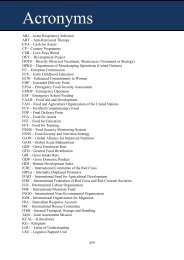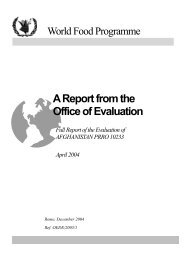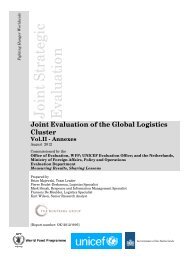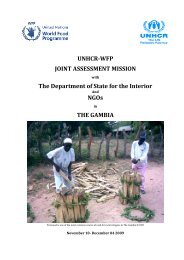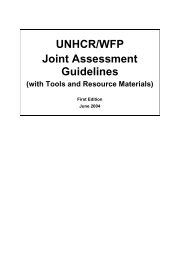Full Report - WFP Remote Access Secure Services
Full Report - WFP Remote Access Secure Services
Full Report - WFP Remote Access Secure Services
You also want an ePaper? Increase the reach of your titles
YUMPU automatically turns print PDFs into web optimized ePapers that Google loves.
<strong>Full</strong> <strong>Report</strong> of the Evaluation of the Kosovo EMOP 6040<br />
Food was trucked by commercial transports from the port of Durres to distribution points in<br />
northern Albania. This commercial modality was successful and economical and continued to be<br />
applied over the next period. No food was to be stored in the refugee affected areas of the North<br />
because of the unstable security situation. As recipients of the food delivery, NGOs were<br />
responsible for ensuring that food was not diverted to combatants in the surrounding area.<br />
Finally, Albania accepted the largest number of Kosovar refugees amounting to over 450,000 in<br />
June 1999.<br />
3.2.4 Macedonia (FYRoM)<br />
In January 1999, out of a refugee population of some 5,000 persons located in FYRoM, only 880<br />
refugees had been registered. Two assessment missions in 1998 concluded that there was no<br />
need for food aid. The escalation of the conflict in Kosovo in late March 1999 saw a dramatic<br />
increase in the number of refugees with some 250,000 entering FYRoM.<br />
FYRoM, in the beginning, did not acknowledge the arrival of Kosovar refugees in the country.<br />
Kosovars with correct documentation could travel to FYROM for a limited stay. <strong>Report</strong>s indicated<br />
the relocation of many women, children and elderly people from Pristina and southern towns in<br />
Kosovo to FYRoM to escape the fighting. The people stayed on tourist visas and were not yet<br />
registered with the local authorities for assistance.<br />
Although the government denied the existence of Kosovar refugees in FYRoM, there were strong<br />
indications that the country might become an important escape route for Kosovars from the<br />
southern areas of Kosovo. On the basis of these considerations, UNHCR and <strong>WFP</strong> agreed to a<br />
planning figure of 20,000 refugees. A <strong>WFP</strong> office was, however, not opened immediately.<br />
As and when food assistance to Kosovar refugees in FYRoM would become necessary, <strong>WFP</strong><br />
would deliver it to the UNHCR warehouse in Skopje. Thereafter, <strong>WFP</strong> and its implementing<br />
partners, such as CRS, would be responsible for the management and control of the food.<br />
Distributions would be carried out through UNHCR and the Macedonian Red Cross.<br />
3.2.5 Montenegro (FRY)<br />
In Montenegro, the government made a request for international assistance on 23 June 1998.<br />
<strong>WFP</strong> food from contingency stocks was delivered at the same time as the government released<br />
some 125 tons of mixed commodities from their own supplies. The government maintained an<br />
open door policy towards the arrival of IDPs.<br />
There are two types of food aid beneficiaries in Montenegro:<br />
Serb refugees from the conflicts in Croatia and Bosnia, and<br />
IDPs from Kosovo since the summer of 1998. The later include ethnic Albanian Kosovars, and<br />
more recently Serb IDPs.<br />
With a deteriorating economic situation and growing instability within the Republic of Montenegro,<br />
there was a continued need to provide food assistance to IDPs, refugees and to those waraffected<br />
people who have lost the means to support themselves.<br />
In Montenegro, the influx of IDPs from Kosovo continued. In October there had been more than<br />
30,000 IDPs in Montenegro. With average daily arrivals of approximately 200 people, the IDP<br />
population increased steadily. UNHCR and <strong>WFP</strong> agreed on a planning figure of 40,000<br />
beneficiaries in Montenegro.<br />
Distributions were going through the Montenegrin Red Cross (MRC) in conjunction with the<br />
Montenegrin Commissioner for Refugees. <strong>WFP</strong> staff members based in Podgorica were<br />
responsible for the management of the food aid as well as monitoring. Distributions were on a<br />
monthly basis and <strong>WFP</strong> Montenegro remained responsive to the ever-increasing IDP caseload.<br />
12


